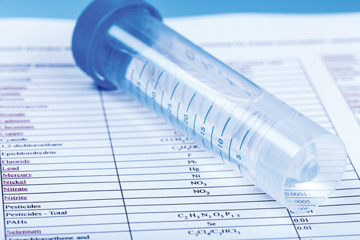
By Lynda King
Recent mailings to Bolton homes by area water testing companies have prompted some people to wonder, should I be worried about my water? What’s in it? How can I be sure it’s safe? Where does it come from anyway?
Well, well, well
Most residents in Bolton don’t have to worry about water coursing through aging city water pipes to get to their homes, because most homes in town get their water from private wells on their own property. In Massachusetts, local Boards of Health regulate private wells. They are the authority that issues permits for new wells to be dug, and they establish criteria for siting those wells and set standards for well output. They also sign off on the safety of a new well’s water.
According to Chris Slade, chair of Bolton’s Board of Health, there is no standing aquifer in Bolton, and most Bolton homes get their water from wells dug more than 100 feet deep to reach water under the bedrock.
Shawn Greenaway of Skillings & Son, a soup-to-nuts well company that has done work in Bolton for about 15 years, explained that these wells are actually made up of fractures deep within the rock, and it is the water flowing through those fractures that feeds the wells.
What’s in a test?
Slade said that after a new well is constructed in Bolton, it is chlorinated and cleaned, then sampled for testing.
“Water must meet state standards,” he said, “and most [wells in Bolton] pass.” Further, he added, once tested, “That’s it. There’s no town requirement for repeat testing.”
Greenaway said that the initial well water test required by Bolton is a common test—known as a “comprehensive test”—that samples for acceptable levels of coliform, arsenic, calcium, copper, iron, lead, magnesium, manganese, potassium, sodium, alkalinity, ammonia, chloride, chlorine, color, conductivity, fluoride, hardness, nitrates/nitrites, odor, pH, sediment, sulfates and turbidity.
After a new well is dug, well drillers are required to submit a “Well Completion Report” to the local BOH as well as the Mass. Department of Environmental Protection. Residents curious about the origins of their wells can contact the MassDep or the Board of Health for a copy of this report, which contains details about well construction, geologic descriptions and test results.
Although there is no state requirement for repeat testing, the Environmental Protection Agency of New England suggests that the standard analysis be performed every 10 years, and advises sampling for bacteria, pH and nitrates/nitrites annually.
And even though some towns in the state may require another water test upon the sale of a property, Bolton does not. However, there may be testing required by other entities, such as mortgage lenders, before ownership of a property is transferred. EPA New England advises realtors to encourage sellers to have the water tested before putting their house on the market, to avoid problems during a sale, and to use water quality as a selling point for the home.
Dave Knowlton, lab director for Nashoba Analytical in Ayer, who said his company does “a lot of water testing” in Bolton, pointed out it is “imperative” for homeowners to have their water tested before a sale, “to avoid any costly surprises.”
What are the risks to local water supplies?
Some of the geologic properties of our region may raise concern about water quality, and in Bolton, as well as surrounding towns, the concern is with the presence of naturally occurring arsenic and uranium.
The United States Geologic Survey (USGS) did a study in 2011 of well water from bedrock in East-Central Massachusetts, and in its report provided a map showing the likely risk of arsenic levels in wells across the region exceeding established standards. (The map can be found online at www.mass.gov/eea/docs/dep/water/drinking/au/potential-state-ar.pdf.)
The color-coded legend on the map indicates “The Percent Probability of Exceeding the Public Drinking Water Standard of 10 Micrograms Per Liter,” and puts the risk at less than 1 percent on the east-northeast side of Bolton. A portion of the middle-western side of town has a risk of 5 to 10 percent, according to the study, and the west-northwest side, 10 to 25 percent.
According to Bolton resident Dan Gaffney, founder of the local water testing company Safewell, the USGS map is “fairly accurate.” He said the levels/risks indicated on that map are consistent with what his company is seeing in its testing.
Greenaway said that even though there is “a lot of arsenic” known to be in New England water, his company hasn’t seen a lot of it where they’ve tested in Bolton, at least not above acceptable levels.
Knowlton told the Independent that the most common problems his company has seen in Bolton are high iron and/or manganese, low pH (acidic), and less frequently, arsenic.
Asked if Bolton might be at higher risk that other towns for certain contaminants, Knowlton said, “No, Bolton is actually at lower risk than other towns for the more serious contaminants.”
As for other concerns?
Acid rain was once a concern for well owners, but isn’t much of a concern now, according to the Board of Health.
Slade said, “Twenty years ago or so it was. We were getting acid in the air drifting out here from coal-burning states in the west.” But that situation has greatly improved, he added. “At the present time, we don’t have a noticeable threat from acid rain.”
Whether the source is rain or not, Knowlton noted that, “In general, for all towns we have seen more and more acidic water problems.”
What about contamination from ordnance use at Devens?
“I know of no threat to Bolton from Devens,” Slade said. He explained that Devens is on the far side of the Nashua River watershed, so surface water runoff from Devens would flow north and west, toward Ayer and Shirley. Most of Bolton is in the Concord River watershed, where surface water drains south and east toward the Concord River.
As for the ordnance at Devens, Slade said that ordnance “tends to stay in the ground and doesn’t move much,” so is unlikely to contaminate groundwater. He said that authorities at Devens do periodically check for signs of contamination around the firing ranges.
Ch-ch-changes
Once a well has been tested, that’s not necessarily the final word on the quality of the water. Greenaway said his company recommends that homeowners have a comprehensive well water test done every five years. After the initial test, he said, homeowners often don’t think about doing any additional testing. But, he explained, “All the harmful stuff is invisible. A well can change; over time, a fracture could dry up and another one could open, changing the makeup of the water in the well.”
Safewell’s Dan Gaffney concurs. “Yes, water does change over time,” he said. His company has sampled hundreds of wells in and around Bolton, and he said that in one well tested, they found the arsenic level in that water had “more than doubled” over a three-year period.
But beyond changes in the water, Gaffney said, testing standards for the presence of certain elements in water can change over time as our understanding of disease changes. He said that when the standard for arsenic was first established, it was 50 parts per billion. However, in 2001 it was changed to 10 parts per billion. “It’s possible that homeowners are unaware of that change and have not considered retesting their wells,” he said.
EPA New England recommends that wells be retested following repairs or modification to the home’s water delivery system (i.e., the plumbing), and advises that if residents notice a change in the appearance, taste or smell of their water, they should have it tested. The agency also advises that a regular testing program may be appropriate in homes located in heavily developed areas or that are in close proximity to land uses involving hazardous chemicals.
Homeowners are ultimately responsible for the safety of their drinking water, including bearing the costs of testing as well as any remediation that might be required. Water tests can cost as little as $30 or more than $200, depending on test parameters. Remediation could include chemical treatment to address bacteria-related issues, or filtration systems to remove other contaminants. Filtration systems can cost $30 to $300 for portable versions, or up to $5,000 for whole-house systems.
Gaffney said, “The challenge with a portable filter is that you must first understand your baseline”—what’s in the water to start with?
He also noted that people shouldn’t be fooled into thinking they can just boil their water to remove anything harmful. He said, “When it comes to metals in water, boiling the water does not help. They can’t be boiled away.”
He added, “People should understand the reasons for testing their water, and why things change.”